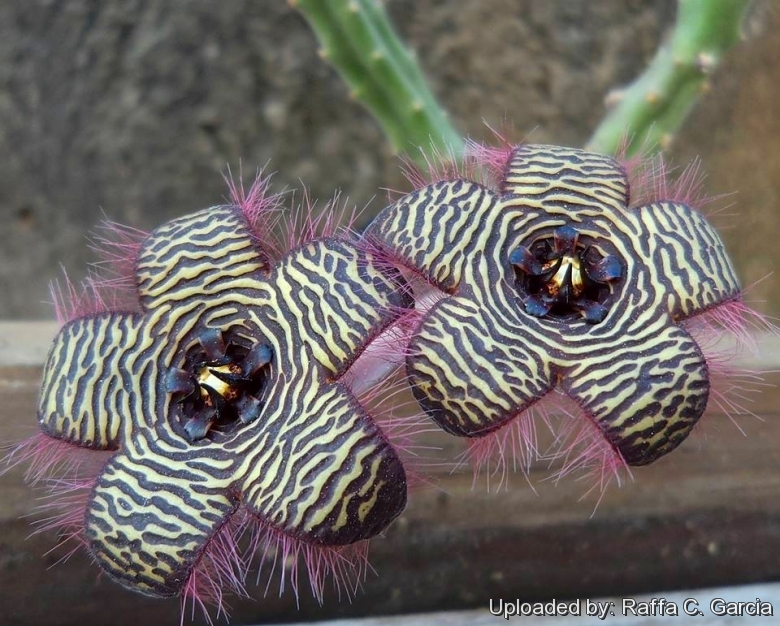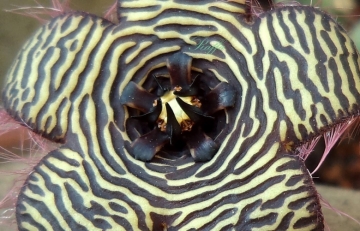
Stapelia villetiae Photo by: Raffa C. Garcia
Origin and Habitat: Northern cape, South Africa
Synonyms:
Common Names include:
RUSSIAN (Русский): Стапелия волосистая
Description: Stapelia villetiaeSN|30262]]SN|30216]] is an uncommon S. African species forming clumps of stems about 15 cm tall. It is known by its very handsome and highly curious star-shaped flowers held distinctively upright, 6.5 cm across, blackish in colour with transverse yellowish lines. The plants are large and robust and forms lax clumps, that sometimes spread for up to 50 or more cm with stems arising from a short horizontal base. It is related to Stapelia cedrimontanaSN|30216]]SN|30262]].
Stems: The stems are shortly decumbent-erect, green, sometimes purple often weakly glossy and up to 16 (or more) cm long, 1.5 cm across, with blunt angles, hairy, tubercles decurrent, with a minute tooth at the base of the ultimately marcescent tips.
Leaves; Rudimentary, slightly spreading..
Flowers: Self-fertile, usually solitary (or in few flowered heads), star fish-shaped, directed up-wards and produced from the base on younger shoots. Peduncle robust, densely white-blotched c. 65 mm long 4 mm wide. Sepals 6-8 mm. Corolla to 6.5 cm across, shallowly campanulate, outside pale green, finely stippled with purple, lobes brown, inside dark flesh-coloured or blackish, wrinkles whitish or (lemon-) yellow. Limb shallowly bowl-shaped. Lobes ovate, shortly pointed. spreading, curved outwards, apically ± black. rarely greenish, 16-23 mm long, outside weakly pubescent, inside glabrous apically and marginally at times delicately roughened, margins hairy; hairs reddish or magenta. Corona black- or reddish-purple. Outer corona-lobes dark red or black, usually oblong, c. 3.5 x 2 mm rectangular-spatulate and obtuse or truncate, diverging, with flat longitudinal groove, apically. with short mucro or delicately crenate, placed on the corolla. Inner corona-lobes c. 5 mm high, with erect 3-angled, apical appendage slightly falcate. Pollinia glossy chestnut-brown or usually orange.
Fruits: Paired follicles.
Bibliography: Major references and further lectures
1) Focke Albers, Ulrich Meve “Illustrated Handbook of Succulent Plants: Asclepiadaceae: Asclepiadaceae” Volume 4 Springer Science & Business Media, 2002
2) L. C. Leach “A Revision of Stapelia L.: (asclepiadaceae)” Aloe Books, 1985
 Stapelia villetiae Photo by: Raffa C. Garcia
Stapelia villetiae Photo by: Raffa C. GarciaSend a photo of this plant.The gallery now contains thousands of pictures, however it is possible to do even more. We are, of course, seeking photos of species not yet shown in the gallery but not only that, we are also looking for better pictures than those already present.
Read More... Cultivation and Propagation: Stapelia villetiae is an easy obliging blooming plant when mature, but seldom flowers when young and is a litle difficult to grow, but when it finally does flower it makes it all worthwile.!
Soil: Since roots are quite shallow, use a cactus mix or add extra perlite or pumice to regular soil potting soil. A gritty, very free-draining compost is suitable, and clay pots help the plants to dry out between watering.
Watering: Stapelia require moderately watering through the growing season but enjoy plenty of water and some fertiliser in hot weather, this helps them to flower freely. Water more sparingly in winter according to temperatures. But, as with most asclepiads, it is unwise to leave them wet in cold weather.
Hardiness: Winter care presents no problems at 5°C with plenty of light.
Sun Exposure: Partial sun or light shade.
Pest and diseases: Stapelia species vary in their susceptibility to rotting, but are generally fairly easy to grow, especially if kept pest-free. They are very susceptible to stem and root mealy bugs, and damage from these may well initiate fungal attack. If you do have problems with a stem or with basal rotting, you can reliably isolate the healthy parts, dry them off, and re-root them in moist compost.
Cultural Practices: Re-pot every 2 years.
Propagation: Easiest with stem cuttings. Allow cuttings to dry a day before planting. Stems must be laid (Not buried) on gritty compost and will then root from the underside of the stems. It can also be increased from seeds sowing in spring in moist, sandy peat moss. Barely cover seeds.












